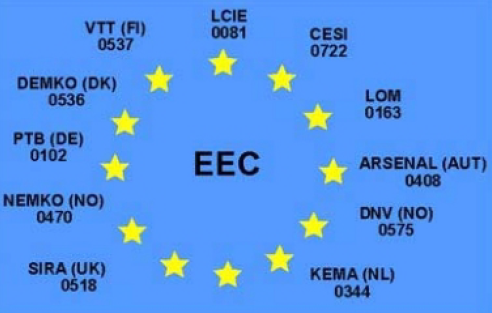ATEX INFORMATION
Two European directives concerning safety with gas and explosion hazards have come into effect through an amendment to Dutch Working Conditions Decree of 1 July 2003. They are Directive 94/9/EC (ATEX 95), which contains the essential health and safety requirements that devices and safety systems have to meet if they are intended for use in places where an explosive atmosphere may occur; and Directive 99/92/ED (ATEX 137), which sets rules for safe working in an explosive environment.
ATEX stands for Atmosphères Explosives. Atex 95 and 137 relate to Articles 95 and 137 respectively of the convention establishing the EC concerning the improvement of the working environment.
The amended Working Conditions Decree stipulates which obligations the employer has to meet if the work is carried out in an explosive environment.
The obligations are as follows:
-
- First, the employer must draw up a written explosion hazard document based on a Risk Assessment, including an identification and assessment of the explosion hazards.
-
- Secondly, the employer must divide a work area with an explosive atmosphere into classified danger zones and mark off these zones with a hazard sign. The new hazard sign is triangular and contains the letters EX. Employers are given until 1 July 2006 to obtain the new signs.
-
- Thirdly, the employer take measures to prevent the occurrence of an explosive atmosphere to as great an extent as possible. If that is not entirely possible, ignition of the atmosphere must be prevented, e.g. by only using materials that cannot cause any sparks or high temperatures. Of an explosion occurs despite this, the employer must ensure that the effects remain as limited as possible.
The Working Conditions Decree contains a transitional law that enables employers to adapt their workplaces to the new rules. Workplaces that were already in use prior to 1 July 2003 must meet the provisions of the amendment decree by 30 June 2006. Workplaces that were taken into use after 1 July 2003 or which have been changed, extended or renovated since that time must comply directly with the new rules. ATEX directive.
ATEX directive 94/9/EC
From 1 July 2003 all new installations in explosive atmospheres must meet the requirements of the ATEX 94/9/EC directive. ATEX is derived from the French “ATmosphère EXplosible”. The implementation of this new directive began on 1 March 1996 and will become mandatory on 1 July 2003.
The most important change compared to the previous directive is that ATEX applies not only to gas-explosive environments but also to dust-explosive environments.
The various environments are subdivided into three different zones. Gas: zone 0
1 and 2 for Dust; zones 20, 21 and 22.
| ATEX directive 94/9/EC | ||
|---|---|---|
| Classification in two groups: | Group 1 | for underground |
| Group 2 | for all other places | |
| Group 1a | M1: | high risk in mines |
| M2: | less high risk in mines | |
| Group 2 | Category 1 | high risk |
| Category 2 | risk is likely | |
| Category 3 | risk is probably rare |
Division into zones under ATEX 94/9/EC
All zones are subject to separate ATEX certification. A product certified for gas explosion cannot be used in a dust explosive environment.
| Division into zones under ATEX 94/9/EC | ||
|---|---|---|
| Zone 0 or 20 : | Gas or dust continuously present | More than 1000 hours a year |
| Zone 1 or 21 : | Gas or dust probably present occasionally | Between 10 and 1000 hours a year |
| Zone 2 or 22 : | Gas or dust present for short duration | Less than 10 hours a year |

What is a “Notified Body””
There are now also straightforward rules for all inspection bodies in Europe. The inspection body that certified the product is stated on all ATEX certified products.
Equipment categories
Zone divisions
Only equipment from a certain category can be used in the various zones. No electrical motors may be used in zones 0 and 20. The various categories are shown in the table above. All motors, apart from ii3D, non-conductive material, must be accompanied by a certificate issued by a ‘Notified Body’.
| GAS | DUST | ||
|---|---|---|---|
| Zone 1 | Zone 2 | Zone 21 | Zone 22 |
| II 2G | II 3G | II 2D | II 3D |
| EExn(A) | IP55 | ||
| EExe | EExe | IP65 | Non-conductive matter |
| EExd(e) | EExd(e) | PTC | IP65 |
| Eexd | Eexd | Conductive matter |
Equipment group
| Division principle (standard EN 50 014) | |
|---|---|
| I | Electrical equipment for mines |
| II | Electrical equipment for other situations |
| IIA | Ignition Energy 200 uJ (Propane) |
| IIB | Ignition Energy 60 uJ (Ethylene) |
| IIC | Ignition Energy 20 uJ (Hydrogen, Acetylene, Sulphur carbon) |
NB: IIA comes within the range of IIB and IIC. IIA is lower in ranking
Temperature class
| Division principle (standard EN 50 014) | |
|---|---|
| T1 | Ignition temperature 450°C |
| T2 | Ignition temperature 300 °C |
| T3 | Ignition temperature 200 °C |
| T4 | Ignition temperature 135 °C |
| T5 | Ignition temperature 100 °C |
| T6 | Ignition temperature 85 °C |
NB: T1 falls within the range of T2, etc… T1 is the lowest in ranking. T6 is therefore the ‘heaviest’ version.
Documentation for ATEX products:
The documents to be supplied with the product form an important aspect of the ATEX:
- Atex certificate of fan manufacturer (in Dutch) with the Atex Code that the fan meets
- Atex certificate of the motor manufacturer
- Manufacturer’s Declaration of Conformity (B2 Declaration)
- Fan installation and maintenance instructions
- Motor installation and maintenance instructions


